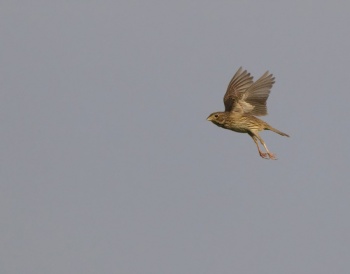- Emberiza calandra
Miliaria calandra
Identification
Largest of the buntings
- Light buffy-brown upperparts with darker streaks
- Paler rump
- Whitish underparts with streaked breast
- Longish forked tail (no white on sides)
- Thick, dark-ridged buff bill
- Pale eye-ring
Distribution
Widespread and still fairly common over much of the Region but has declined dramatically in some areas of North-West Europe and Scandinavia and Britain in particular.
Breeds in the British Isles (scarce in the north and west and in Ireland), and from western France and Iberia east across Europe to Belarus, Ukraine and southern Russia to the Caspian, but absent from major mountain ranges. In the north breeds in Denmark but very rare in southern Sweden, more common in Poland.
In the south breeds on the Balearics, Corsica and Sardinia, much of Italy and Sicily, southern Greece, Crete, Cyprus and Turkey, the Caucasus and northern Iraq. Also breeds in the Middle East south to northern Israel, in North Africa in Cyrenaica and from central Morocco to northern Tunisia and on the Canary Islands (although absent from Lanzarote and Fuerteventura).
Taxonomy
Subspecies
Clements recognizes these subspecies[1]:
- E. c. calandra: breeds from Europe (including the British Isles and extreme southern Sweden) east to Belarus, Ukraine, and southern Russia, Turkey (except the southeast), and coastal Lebanon and Israel; also northwestern Africa (Morocco east to Libya) and the Canary Islands; partially migratory
- E. c. buturlini*: breeds from southeastern Turkey south to northern Israel, east across Syria, Iraq, and western and northern Iran to Turkmenistan and northern Afghanistan, also north through Tajikistan, southeastern Uzbekistan and Kyrgyzstan to southern Kazakhstan and extreme northwester China (extreme western Xinjiang); isolated population in Arabian Peninsula probably also this subspecies; partially migratory
Habitat
Open country with trees, roadside hedges, wetlands, farmland and scrubby areas.
Behaviour
Breeding
Males are Polygynous, and may have up to three females each. The females take sole charge of nest building and care of the young.
Vocalisation
Song: delivered from a perch and has been likened to jangling keys, or breaking glass
References
- Clements, J. F., T. S. Schulenberg, M. J. Iliff, T. A. Fredericks, J. A. Gerbracht, D. Lepage, S. M. Billerman, B. L. Sullivan, and C. L. Wood. 2022. The eBird/Clements checklist of Birds of the World: v2022. Downloaded from https://www.birds.cornell.edu/clementschecklist/download/
- Gill, F, D Donsker, and P Rasmussen (Eds). 2023. IOC World Bird List (v 13.2). Doi 10.14344/IOC.ML.13.2. http://www.worldbirdnames.org/
- Birdwatchers Pocket Guide ISBN 1-85732-804-3
- Cyprus Wildlife
Recommended Citation
- BirdForum Opus contributors. (2025) Corn Bunting. In: BirdForum, the forum for wild birds and birding. Retrieved 30 April 2025 from https://www.birdforum.net/opus/Corn_Bunting
External Links
GSearch checked for 2020 platform.1





